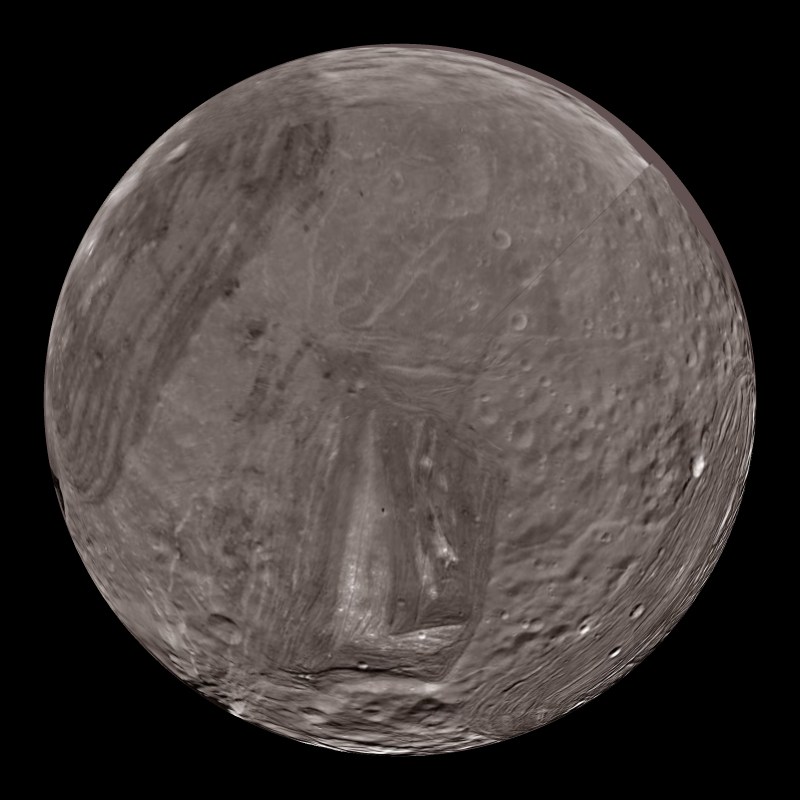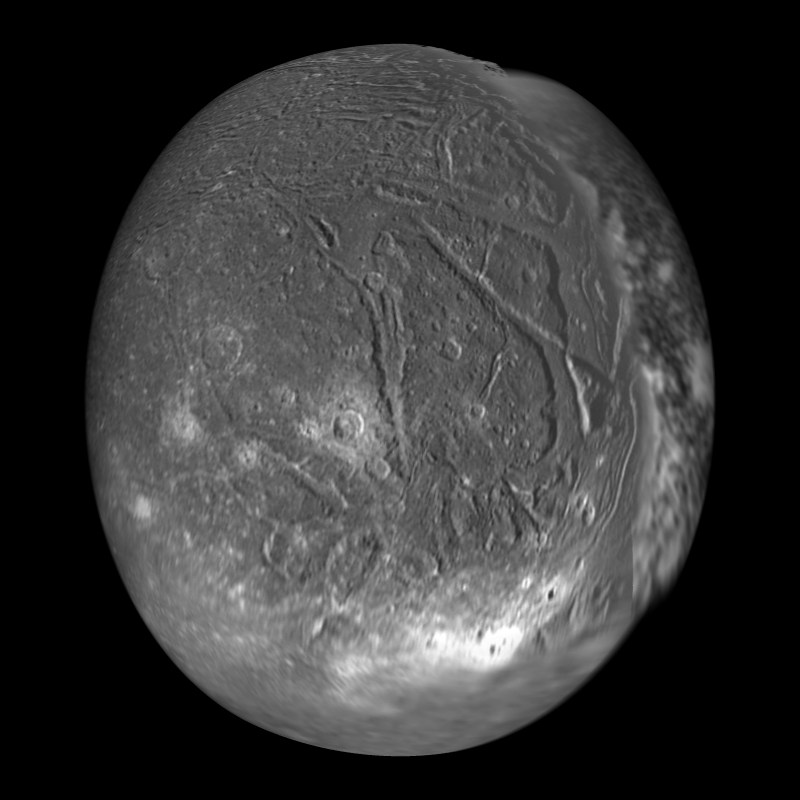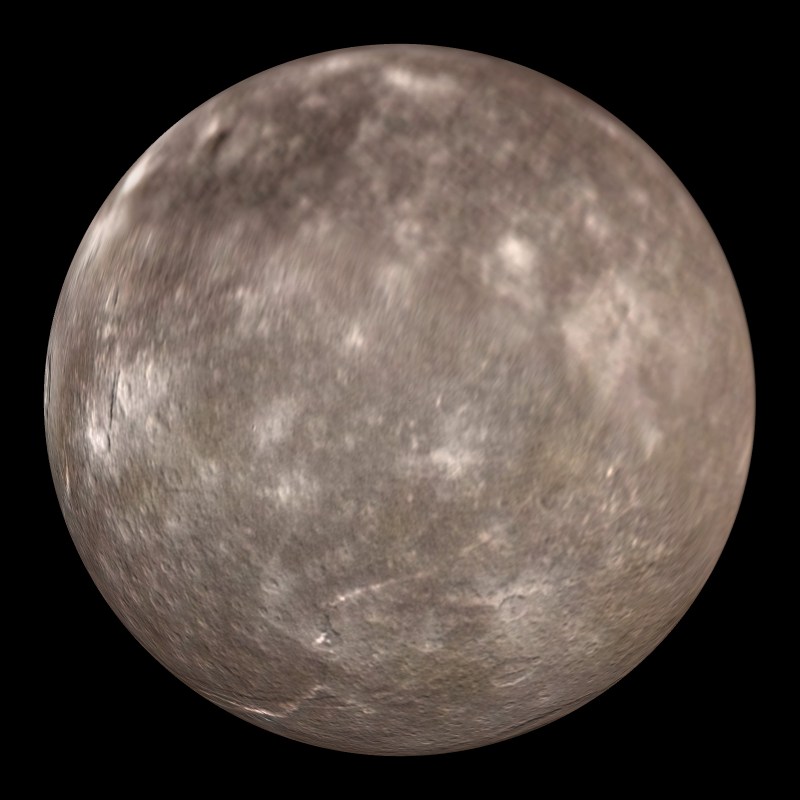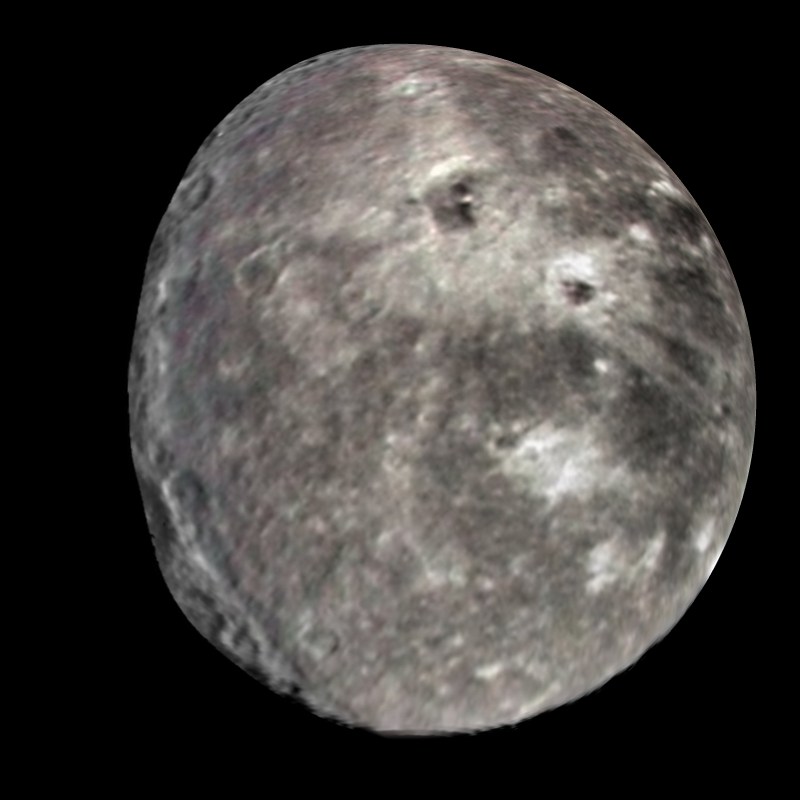Uranus’ Moons — Miranda, Ariel, Umbriel, Titania, Oberon
Description:
Uranus has 27 moons, all of which are named after characters in Shakespeare and Alexander Pope works. The five main satellites, in order of proximity to Uranus, are Miranda, Ariel, Umbriel, Titania, and Oberon. Before the Voyager 2 studied Uranus in 1986, these five moons were the only ones known to exist.
 Miranda
MirandaMiranda (a character in The Tempest by Shakespeare) has a surface unlike any other in the solar system. One theory for the jumbled appearance is that the moon has shattered and reformed up to five times, creating a surface of both young and old material. Another explanation involves the upwelling of partially melted ices.
 Ariel
ArielAriel (a character in The Tempest by Shakespeare and also a character in a Pope poem) is the brightest moon of Uranus. The most notable features on this moon are the craters that cover the surface as well as the interconnected rift valleys that run across the moon. Some of the valleys are up to 6 miles deep.
 Umbriel
UmbrielUmbriel (a character in The Rape of the Lock by Pope) is the darkest moon of Uranus. It is also the least geologically active satellite with a heavily cratered surface indicating that it is old. Near the equator of Umbriel is a bright ring referred to the as the Fluorescent Cheerio or Wunda. The origin of this is unknown, though it is believed to be the floor of a crater.
 Titania
TitaniaTitania (Queen of the fairies in A Midsummer Night’s Dream by Shakespeare) has a surface remarkably similar to that of Ariel. Covered in craters and interconnected valleys like Ariel, Titania is 35% larger than Ariel and is the largest of the known satellites orbiting Uranus. One of the most notable features is a trench that extends for over 1000 miles. It is thought that the satellite was once hot and the valleys and trenches are the result of the planet freezing and expanding.
 Oberon
OberonOberon (King of the fairies in A Midsummer Night’s Dream by Shakespeare) is similar to Umbriel but 35% larger. Heavily cratered and geologically inactive, Oberon is the second largest moon of Uranus. In many of the large craters that cover the surface there is a dark material that coats the crater floors. It is still unknown what causes this. Also of interest on Oberon is a mountain that is over 4 miles tall.
Data Category
Major: Astronomy
Minor: Uranus
Keywords:
Astronomy, moon, Uranus
| Data Set Name | Miranda (Uranus moon) |
| Data Set Directory Name | uranus_moons/miranda |
| Data Set Source | Voyager Image details |
| Data Set Developer | David Seal William Johnston |
| Visualization Developer | Steve Albers, NOAA/GSD |
| Audio | No |
| Download | FTP |
| Data Set Name | Ariel (Uranus moon) |
| Data Set Directory Name | uranus_moons/ariel |
| Data Set Source | Voyager Image details |
| Data Set Developer | David Seal Ted Stryk Steve Albers NOAA/GSD |
| Visualization Developer | Steve Albers, NOAA/GSD |
| Audio | No |
| Download | FTP |
| Data Set Name | Umbriel (Uranus moon) |
| Data Set Directory Name | uranus_moons/umbriel |
| Data Set Source | Voyager Image details |
| Data Set Developer | Phil Stooke |
| Visualization Developer | Steve Albers, NOAA/GSD |
| Audio | No |
| Download | FTP |
| Data Set Name | Titania (Uranus moon) |
| Data Set Directory Name | uranus_moons/titania |
| Data Set Source | Voyager Image details |
| Data Set Developer | David Seal Ted Stryk Steve Albers NOAA/GSD |
| Visualization Developer | Steve Albers, NOAA/GSD |
| Audio | No |
| Download | FTP |
| Data Set Name | Oberon (Uranus moon) |
| Data Set Directory Name | uranus_moons/oberon |
| Data Set Source | Voyager Image details |
| Data Set Developer | David Seal Ted Stryk Steve Albers NOAA/GSD |
| Visualization Developer | Steve Albers, NOAA/GSD |
| Audio | No |
| Download | FTP |

